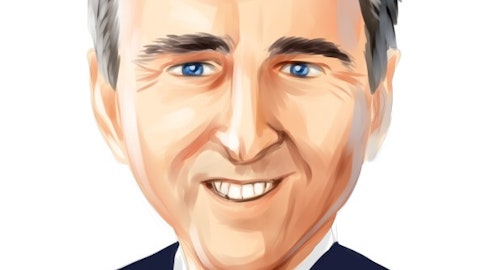Jeff Sprague: Hey. Thanks. Good day, everybody. Hello. Hey, Jim, as you’re well aware, right, there’s a process going on out there for national instruments and a lot of speculation out there about your interest. I’m sure you’re fairly limited on what you might want to say, but any color you could give us on your appetite for any deal at large or you’ve expressed interest in the past and hardware-related deals? Anything there make any sense for you?
Jim Lico: Yes. So, I think, number one, we obviously, know the company and have read the news. So you’re exactly right. We wouldn’t comment on any process that we’ll be involved in or not involved in, particularly a public one. But I would say this. I mean we’ve known NI for a long time. I can remember meeting Dr. T 15 years ago or so. So we know them well. We partnered with them at Tektronix and have for a long time. So I think what we’ve said strategically about all of our funnel was there was a balance of large, small deals, hardware and software. So we can — the balance sheet is an incredible place right now, as you know. So we’re in a great place to do things. But we’re going to be disciplined. We’re going to make sure that every situation we approach, we approach it strategically, how well that accelerates, what we want to do, and I’ll leave it at that.
But I think more broadly around M&A, we’re in a very good place relative to our opportunities ahead of us. And we’ll — we certainly are playing offense in that regard.
Jeff Sprague: Great. Thanks for that. And then just totally shifting gears. Just back to kind of the inflationary pressures in AHS. At this point, do you have the cost and other actions in place to be neutral or better as we move through 2023? Maybe just put a little finer point on how you see kind of price cost and kind of the margin impact playing out over the balance of the year?
Jim Lico: Yes. So I think, more specifically around AHS, we called out a couple of kind of onetime headwinds in the quarter. We — I think there’s a number of things that are working in our favor relative to the 2023 year. Number one is North America. We had good growth in North America and anticipate that will continue — we’re not necessarily calling everything getting perfect in North America, but we do believe it will get better. And we saw that in the fourth quarter, and that’s a good thing for our margin structure. And then number two, to your point, we’re seeing a little bit more price realization in the fourth and into this year. Things are starting to get a little traction. We’ve talked about that on the call that it just takes longer, and we’re starting to see that.
And then finally, productivity. The team has — that leadership team has really adopted FBS, and they’ve really embraced a number of things to really drive productivity. So, we don’t see the additional inflation either as well. So the combination of we don’t see incremental inflation at this point and we have those actions getting deeper and deeper into the margin structure, if you will, through the year. So, we feel like we’re in a much better place starting here in 2023, both from a market and obviously, the kind of actions that we need to continue to make the business better. And I would just kind of ask, but we have grown gross margins in AHS — operating margins about 130 basis points over the last two years. So, despite those challenges, we’re in a good place.
I call that the launch path from where we are today.
Jeff Sprague: Great. I’ll leave it there. Thank you.
Jim Lico: Thanks Jeff.
Operator: Our next question comes from Nigel Coe from Wolfe Research. Please go ahead. Your line is open.
Jim Lico: Hi Nigel.
Nigel Coe: Thanks, good morning everyone. Hey guys, how are you? By the way, is going to be very happy, you put them in that competitive basket. So, just want to follow-up on Jeff’s question, obviously, the National Instrument news is out there. Where do you stand philosophically on issuing equity for a deal? Because based on the math of we’re doing — your leverage will get to very high levels. So, just wondering, what is the leverage ceiling you prepare to go to for the right opportunity? And philosophically, would you issue equity for the biopsy?
Chuck McLaughlin: Nigel, it’s Chuck. We’ve always felt we want to maintain an investment-grade rating. And so we wouldn’t do anything that — on any type of deal that would jeopardize that. I’ve pointed out in the past, we’ve done equity instruments, like the mandatory convert. And we’ve always said that in situations where we want to do something, equity has never been off the table. It just hasn’t been needed at this point.
Nigel Coe: Okay, that’s helpful. And then just going back to the FY 2023 plan. How much of that $350 million surplus backlog are you sort of planning to eat into underpinning your plan? And then maybe just touch on the service channel SaaS transition. It seems like it’s a very sort of discrete sort of intra-quarter, maybe 1Q first half event. These SaaS transitions tend to be kind of drawn out when we look at other companies. So, just curious why that would be so short-term?
Chuck McLaughlin: Nigel, I’ll take the first part. We would expect to take of the excess backlog that we’re talking about probably up to half of it is included in the assumptions for this year in this guide. But to be clear, this is what we consider excess. And that’s still — we get more out if supply chains get better. So there’s a little more there, but it’s still constrained by supply chain throughout this year. But getting back Nigel on the service channel question, I wouldn’t think of it as a SaaS transition. The SaaS revenue has continued to be good. It’s just — we grew the business well over 70% in Q1 of 2022 and so with a large amount of this just pass-through revenue. And so if you think about it, we have a customer.
Some of our contracts have. We’re passing through a number of amounts of the facility maintenance costs that they have pain plumbers or electricians. We’re just doing less of that. And so it’s really not a SaaS transition in the traditional sense. That we’re replacing that solution, though with some other added benefits. And so we — that’s why it’s a short-term transition. It’s really kind of going from losing some of this one-time pass-through revenue and quite frankly, we didn’t make any money on. So I would see it as that, and that’s why it’s short-term as opposed to sort of a conversion of what you’d see traditional license revenue to SaaS revenue. We’re not going to see that. This is — service channel is 100% SaaS revenue company.
Nigel Coe: Right. Okay. Thank you.
Chuck McLaughlin: Thank you.
Jim Lico: Thanks.
Operator: Our next question comes from Andy Kaplowitz from Citigroup. Please go ahead. Your line is open.
Andy Kaplowitz: Good afternoon, guys.
Chuck McLaughlin: Hi Andy.
Andy Kaplowitz: Jim, you and Chuck mentioned increased productivity initiatives planned in all segments that primarily benefits the second half of 2023. I think you already mentioned FBS in AHS, but could you give us a little more color around what the bigger initiatives are and maybe size these initiatives for us? And then if there’s any sort of cost to undertake these initiatives?
Chuck McLaughlin: Yes, Andy, the first half, we’d expect to put up $20 in $25 million to $30 million of cost. See cost to get after some of these structural things. Some of them are looked up, a few of those, but there’ll likely be some outside of the U.S. Maybe there are some regions that we want to convert to a dealer approach rather than a direct approach, and I’m thinking here in our health margins. We’ve always thought that there was cost that we needed to improve our go-to-market there. And we’re just getting after that.
Andy Kaplowitz: Got it. And then Jim, can you give us more color into what you’re seeing by region? It looks like Western Europe has continued to be strong for you. We’ve talked about China and AHS, but outside of AHS is strong. So what are you thinking for 2023? You talked about orders slowing in Western Europe and North America, but are that more a function of supply chain normalizing? Or are more of your customers are little cautious to start in 2023?
Jim Lico: Yes, it’s interesting. I think we’ve always thought for the last several months that customers would inevitably start 2023 out a little more conservative just given we’ve seen some of the Tek layoffs and some of those things, the PMI and where it is. And so that’s number one. That’s number one. That’s kind of a planning assumption from an order perspective. Now we also knowing that we had — we’re starting here with a good backlog situation. I would say, if you think about it regionally, Andy, obviously, North America is going to be pretty good and pretty resilient, given the fact that we have most of our software businesses have the predominance of their revenue streams in North America. And I mentioned the health care, particularly ASP North American story.
So, North America is going to be pretty resilient I would say that Western Europe and Europe more broadly, probably a weaker area for the year, just given a number of things. Some of that is supply chains normalizing a little bit back to normal. Some of it is just a little bit of weakness as well. China is going to be good all year. Healthcare will be weak in China in the first quarter because of the actives but should continue to get better through the year. So that’s kind of the regional play, and that’s sort of our planning assumptions going forward. I think it’s still early days. Obviously, a lot of the year to play out here. But that was — that’s sort of fundamental to our planning assumption.
Andy Kaplowitz: Appreciate it, Jim.
Jim Lico: Thank you.
Operator: Our next question comes from Josh Pokrzywinski from Morgan Stanley. Please go ahead. Your line is open.
Jim Lico: Hi, Josh.





